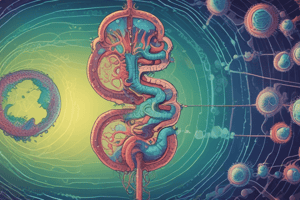Podcast
Questions and Answers
What is the primary importance of macroscopic description of CSF?
What is the primary importance of macroscopic description of CSF?
- To ensure accurate recording of received samples (correct)
- To compare with cytology results
- To determine the requirement of biochemistry tests
- To detect blood staining in the samples
What is the significance of checking the patient name on all tubes?
What is the significance of checking the patient name on all tubes?
- To ensure all tubes belong to the same patient (correct)
- To count the number of tubes
- To check the availability of tubes
- To verify the doctor's prescription
Why are tubes 1 and 3 sent to the biohazard cabinet?
Why are tubes 1 and 3 sent to the biohazard cabinet?
- To perform cell counts
- To centrifuge the samples
- To conduct biochemical tests
- To aseptically load counting chambers (correct)
What happens to the supernatant of tubes 1 and 3?
What happens to the supernatant of tubes 1 and 3?
Why are two sterile pipettes used?
Why are two sterile pipettes used?
What is the approximate percentage of supernatant taken off from tubes 1 and 3?
What is the approximate percentage of supernatant taken off from tubes 1 and 3?
What is the purpose of sending tube 1 supernatant to biochemistry and tube 2 to cytology?
What is the purpose of sending tube 1 supernatant to biochemistry and tube 2 to cytology?
What is the significance of xanthochromia in CSF?
What is the significance of xanthochromia in CSF?
Why is it important to perform cell counts on both tubes 1 and 3?
Why is it important to perform cell counts on both tubes 1 and 3?
What does a high protein level in CSF biochemistry indicate?
What does a high protein level in CSF biochemistry indicate?
Why is it important to record the macroscopic appearance of CSF?
Why is it important to record the macroscopic appearance of CSF?
What is the purpose of adding toluidine blue dye to a CSF sample?
What is the purpose of adding toluidine blue dye to a CSF sample?
Flashcards are hidden until you start studying
Study Notes
Macroscopic Description of CSF
- Importance of accurately recording received CSF samples and their destinations (e.g., tubes 1, 2, and 3 for M, C & S, cytology, and biochemistry)
- Verify patient names on all tubes to ensure correct identification
Processing CSF Samples
- Tubes 1 and 3: cell counts, centrifugation, and supernatant separation for biochemistry
- Tube 2: untouched, sent to cytology
- Combine deposit from tubes 1 and 3 for Gram stain and plate inoculation
- Leave at least one drop of deposit in tube 3
Importance of Macroscopic Appearance
- Record turbidity, bloodstaining, and xanthochromia (yellow-orange color due to broken-down red blood cells, indicating recent subarachnoid hemorrhage)
- Xanthochromia can be detected using a spectrophotometer, and samples should be protected from light
Traumatic Tap vs. Recent SAH
- Traumatic tap: blood from a capillary, detected by comparing cell counts in tubes 1 and 3
- Recent SAH: blood from CSF, no difference in cell counts between tubes 1 and 3
Biochemistry and Cell Counts
- Can indicate possible causes of meningitis, such as:
- Lymphocytes: viral, tuberculous, or yeast (cell-mediated immunity)
- Polymorphs: life-threatening, often with turbid CSF and low sugar levels
- Toluidine blue can help distinguish lymphocytes from polymorphs
Studying That Suits You
Use AI to generate personalized quizzes and flashcards to suit your learning preferences.




